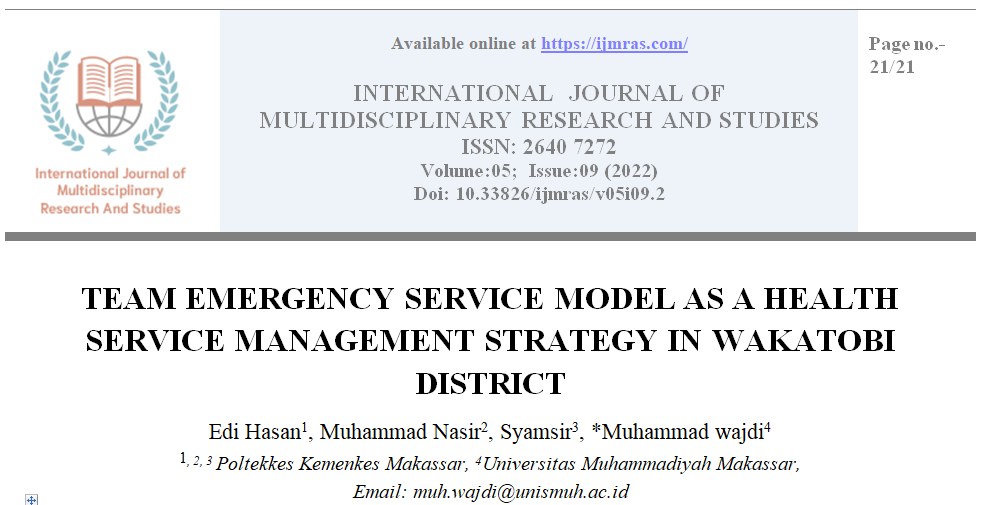TEAM EMERGENCY SERVICE MODEL AS A HEALTH SERVICE MANAGEMENT STRATEGY IN WAKATOBI DISTRICT

Abstract
Public services are closely related to the government, one of which is the concept of development and management with Information and Communication Technology (ICT). The differentiation of the emergency service model is the emergency service team program. The purpose of this study was to determine the feasibility of implementing the emergency service team model in the health care setting. The method used is mixed methods research, which is a combination of quantitative methods that uses quantitative data analysis with SWOT analysis.
Keywords
Information and Communication Technology, SWOT, Public Safety Center, Wakatobi RegencyHow to Cite
References
Akinci.F, Mollahaliloglu.S, Gursoz.H, Ogucu.F, 2012, Assessment Of The Turkish Health Care System Reforms: A Stakeholder Analysis. Health Policy.Vol. 107(1):21–30.
Alif, FAS, 2018, Public Service Innovation Through Command Center 112 in Handling Public Complaints at the Surabaya City Disaster Management and Community Protection Agency (BpbLinmas), Public Policy and Management, Vol.6(1) : 1-13
Arch.D, Frank ZF, Facha, Berry, Robert A, Pietrzak, Michael P, Paratore, Amy, 2008,Integrating Disaster Preparedness And Surge Capacity In Emergency Facility Planning, Journal of Ambulatory Care Management:Vol.31 : 377-385
Bahrami.MA,Maleki.A,Ranjbar Ezzatabadi. M,Askari. R, Ahmadi Tehrani.GH, 2011, Pre-Hospital Emergency Medical Services In Developing Countries: A Case Study About Ems Response Time In Yazd, Iran, National Library Of Medicine, Vol.13(10) : 735–738.
David E. Slattery. Md,Annemarie Silver,2009, The Hazards Of Providing Care In Emergency Vehicles: An Opportunity For Reform, Pre-Hospital Emergency Care, Vol.13(3):388-397.
Dutta, Mohan J. 2011. Communicating Social Change: Structure, Culture, and Agency.Routledge, New York Fallon.BJ,Rice.SM, 2011, Investment In Staff Development Within An Emergency Services Organization:
Comparing Future Intention Of Volunteers And Paid Employees, The International Journal Of Human Resource Management, Vo.26(4) : 485-500
Farhania.N, Wajdiakashah.F, Aniza AA, 2019, Conceptual Framework For Risk Communication Between Emergency Response Team And Management Team At Healthcare Facilities: A Malaysian Perspective,International Journal of Disaster Risk Reduction,Vol. 41
Gandhi TK, Sittig DF, Franklin M, Sussman AJ, Fairchild DG, Bates DW. 2000, Communication Breakdown in the Outpatient Referral Process. J Gen Intern Med,15:26–31.
Hamrun, Nurul KR, Taufik. A, 2020inovation of Health Services Through Disaster Preparedness Brigades in the District Bantaeng,(IIPP)Journal of Political Science and Government Science, Vol.6 (1) : 67-82
kaeIber DC, Bates DW. 2007, Health information exchange and patient safety. J. Biomed. 40:40–5.
Lukas, Bryan A., and OC Ferrell. 2000, The Effect of Market Orientation on Product Innovation. Journal of The Academy of Marketing Science. Vol. 2 ( 28) :239-247
Musyarofah.S (2019) Overview of Public Safety Center Health Services 119, Permas Scientific Journal: Kendal Stikes Scientific Journal, Vol. 9 (4) : 371 – 378
Neil Britton, 2001, A New Emergency Management For The New Millennium?, The Australian Journal Of Emergency Management, Vol.16(4) : 44-54
Nogueira.LC.Jr,Pinto.LR, Silva.PMS, 2016,Reducing Emergency Medical Service Response Time Via TheReallocation Of Ambulance Bases,Health Care Management Science, Vol.19 : 31–42
Shan.S,money.L, Ling Li,ChenY, 2012, An Emergency Response Decision Support System Framework For Application In E-Government, Information Technology And Management, Vol.13 : 411-427
Sultan Zayed K,2010, Response Time As A Sole Performance Indicator In Ems: Pitfalls And Solutions, National Library Of Medicine, Vol.2 : 1–6.
Stokes J, Gurol-Urganci I, Hone T, Atun R, 2015, Effects of Health System Reforms In Turkey On User Satisfaction, J Glob Health, Vol.5 (2).
Widuri Wulandari, 2020,The Implementation Of Smart City In Creating Innovations Of Public Services By Regional Governments (Case Study Of Bandung City And Makassar City), Journal of CarakaPrabu, Vol.4 .
License
Copyright (c) 2022 Edi Hasan, Muhammad Nasir, Syamsir, Muhammad wajdi

This work is licensed under a Creative Commons Attribution 4.0 International License.
Individual articles are published Open Access under the Creative Commons Licence: CC-BY 4.0.



